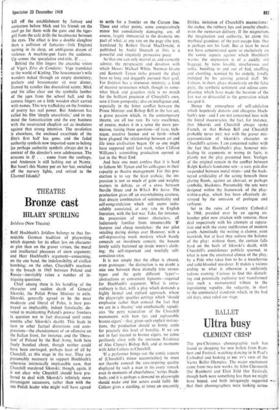Ultra busy
BALLET CLEMENT CRISP
The pre-Christmas choreographic rush has found us shopping for new ballets from Ram- bert and Festival, watching dancing in St Paul's Cathedral and looking at BBC Tv's view of the Varna Ballet Olympics. The major excitement came from two new works, by John Chesworth (for Rambert) and Eliot Feld (for Festival), though both were something less than we might have hoped, and both intriguingly suggested 4.4t that their choreographers were looking across
the Atlantic from their respective shores.
Feld is a young American dancer whbse first two ballets have been hailed with delight in the United States; Festival Ballet, happily con- cerned with improving its repertory of short works, has had the equally happy idea of acquiring one of his ballets. Its choice, Meadow Lark—a title I don't find particularly apposite —is an extraordinary piece to come from America. It strikes me as a would-be Euro- pean ballet, with eighteenth century attitudinis- ing in a fete, not particularly galante, which involves a dozen dancers taking their pleasure in a leafy grot, while at the side of the stage four,musicians provide some backchatting flute quartettery, attributed to Haydn (but Haydn in an off moment, I suspect). It is all very sweet, superficial, prettily set as dancing, and a trifle shapeless; even a divertissement needs some sort of backbone, some structural logic, and this—on one viewing, let me at once admit —is where Feld's inexperience seems to show. He has remarkable facility in invention; the steps flow neatly and nicely, well-rooted in the music, the dancers are shown off handsomely; but in sum the effect is too bland, and also slightly uncertain as to period style (there is a sequence about a Vision of the Beloved that Is brilliantly done, but as anachronistic as a Louis XV telephone).
As a transatlantic view of Versailles it is as strange in its own sweet way as John Ches- worth's feverish Pawn to King 5, which is an entry for the Our Violent Society stakes that Ballet Rambert seems currently to be running. The title is a chess tnove made preparatory to an attack, and the ballet starts with a brawl in which a small girl lets fly at a boy; this sets the mood for a work concerned with aggres- sion in somewhat general and confused terms. The dancers writhe, scream, make love, commit murder and hara-kiri; Jonathan Taylor gives a brilliant impersonation of a wounded soldier frenziedly at odds with the world, and there are intermittent free-for-alls. My impression is of a work concerned with a section of society orientated more to drugs than to living, and Chesworth's group can express itself only by violence. On these terms his commentary is pertinent, but his expressive powers have, I feel, been hamstrung by a score of numbing pretentiousness culled from a recording by the Pink Floyd pop group, and by a dance style that has failed to digest all the modern dance
mannerisms now on view in the Rambert repertory., Like Feld's piece, it lacks, cohesion, but both are young choreographers and we can anticipate better things.
Young choreographers also featured in an unusual evening at St Paul's Cathedral last Saturday, when the Royal Ballet's Choreo- graphic Group joined forces with the cathedral choir to provide a danced realisation of carols. Five choreographers devised the movement, all highly sensitive and devout in imagery, the choir sang angelically, the cathedral showed off its newly cleaned splendours, and Geoffrey Cauley's extraordinary ballet Lazarus suggested that here is a talent quite as interesting as Feld and Chesworth.
Finally BBC TV provides a Christmas box on 29 December with a film about the ballet com- petition staged biannually at Varna, the Bul- garian Black Sea resort. I saw it at a preview, and it makes fascinating viewing; I have several reservations about the ultra-busy camera angles, but the film gives an excellent, if rather dizzying, impression of the sun, sweat and hordes of dancers, and. some fascinating in- sights into East European ideas about dancing. Not to be missed.



































 Previous page
Previous page